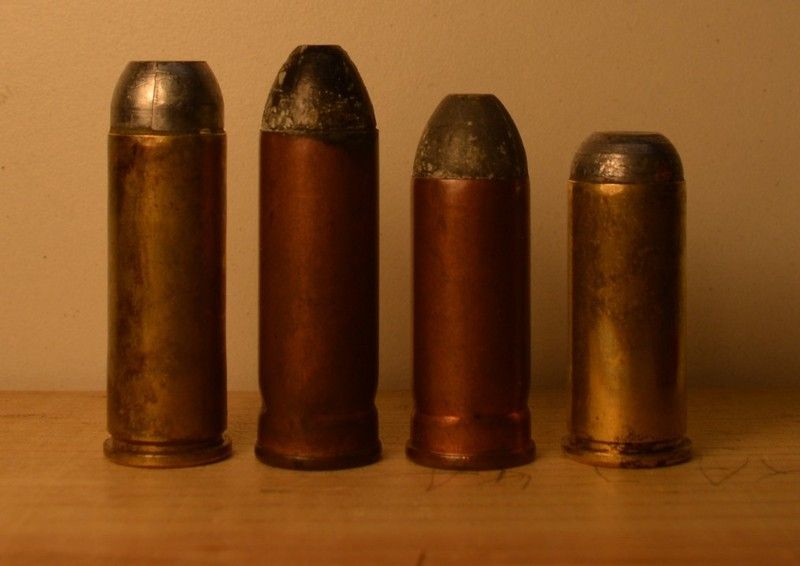Howdy
A word about the 45 Schofield.
Jim K is slightly incorrect when he says that other than length, the 45 Schofield is identical to the 45 Colt. The 45 Schofield has a larger diameter rim that the 45 Colt. SAAMI spec rim diameter for the 45 Colt is .512, SAAMI spec rim diameter for the 45 Schofield is .520. This goes way back to when the Schofield revolver was first developed by Smith and Wesson in 1875. The rim of the Schofield round needed to be larger in diameter than the teeny rims on the old 45 Colt rounds so the extractor would have something to grab. Eventually 45 Colt rims got larger in diameter, but never as big as the Schofield rim.
The relevance to the current discussion is that although 45 Schofields will chamber in a Colt or colt replica with no problem, the larger rim sometimes presents a bit of a problem with a Ruger. This is because of the geometry of the ratchet teeth on the Ruger cylinder. The teeth on a Ruger are basically cylinderical in shape, leaving less clearance around the rims than the 'scooped' cutouts on a Colt or clone. This photo shows the problem graphically, a Ruger 'original model' large frame Vaquero cylinder on the left, a 2nd Gen Colt cylinder on the right. The Ruger cylinder actually would not accept the Schofield round in one chamber, the rim interfered with the ratchet teeth. This was easily remedied with a few careful strokes of a file, but I have two stainless Vaqueros that were stubborn about accepting 45 Schofield rounds, only ever modified one.

Regarding the price of 45 Schofield ammo, a quick check at Midway USA showed that loaded 45 Colt ammo runs from about $37 per box to about $60 per box. 45 Schofield is running from $40 per box to $60 per box. Neither of these cartridges is cheap to shoot unless you handload.
There is a cartridge called .45 Cowboy. It is essentially a rimmed .45ACP, but is different from the .45 Auto Rim because it has a rim the same thickness as a .45 Colt.
I didn't know about the .45 Cowboy; I thought ".45 cowboy" loads were just light loads in the regular .45 Colt. I do know that the old .45 Schofield (aka .45 Government) is being loaded but is quite expensive. It is shorter than the .45 Colt but longer than the .45 ACP.
The name of the cartridge is 45 Cowboy Special. Not to be confused with 45 Colt 'Cowboy Loads'. The 45 CS (cowboy special) was developed about 10 years ago. The idea was to make a more efficient case for lightly loaded 45s used in Cowboy competition. Many CAS shooters buy revolvers chambered for 45 Colt because of the romance of the old cartridge, but wind up loading it down ridiculously low so that it recoils about the same as a lightly loaded 38 Special. The huge, cavernous case of the 45 Colt does not do well when loaded too lightly, because of the large volume of air left in the case with light loads. When loaded down to Mousefart levels the powder can burn inefficiently resulting in inconsistent loads. I have cleared stuck bullets out of guns where the shooter simply did not put in enough powder to get the bullet out of the barrel.
The 45 CS is the same length as the 45 ACP and 45 Auto Rim cartridges, but it has the same rim configuration as the 45 Colt. It will chamber in any revolver chambered for 45 Colt. Since the 45 CS has the same interior volume as the 45 ACP, 45 ACP loading data can be used with it. More to the point, very light loads that could be a problem in the 45 Colt case are not a problem in the 45 CS because there is so much less empty air space in the 45 CS when loaded lightly.
45 CS brass was produced by Starline but could only be purchased from the inventor of the round. A few years ago he left the business and nobody was making the brass anymore. Just recently, within the past month, a new outfit has again started marketing the 45 CS brass, and loaded ammo is available on the market for the first time.
In this photo, the cartridges left to right are 45 Colt, 45 Schofield, 45 Cowboy Special, 45 Auto Rim, and 45 ACP. Note that the 45 AR has a rim .090 thick, too thick for any revolver that does not have enough headspace. The .090 rim is to make up for the extra thickness of half moon clips commonly used with Colt or S&W 1917 revolvers.




